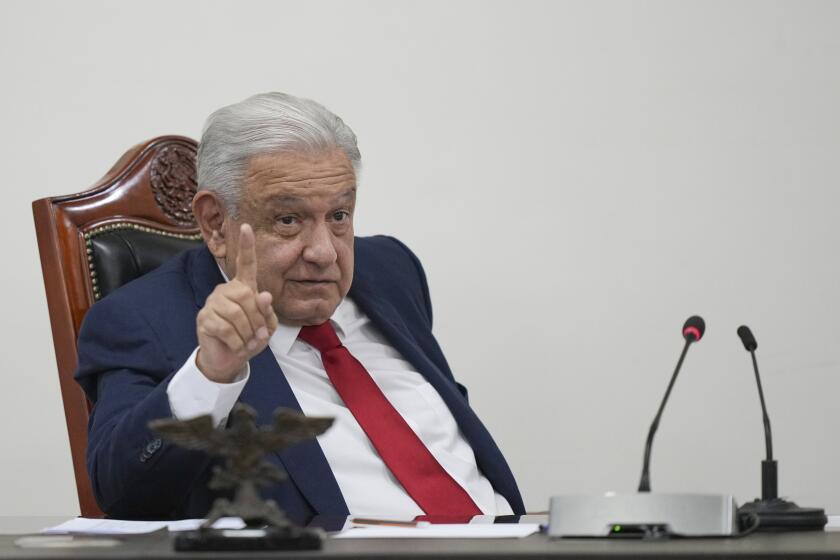Hezbollah Wields Improved Arsenal
The first rocket from southern Lebanon to hit this bayside city has made it clear that Hezbollah now has missiles that can strike targets deep in Israel, and that the militant group is prepared to use them.
On Friday, a length of police tape marked the site where a rocket had slammed into a hill the night before in Israel’s third-largest city.
The strike about 20 miles from the border with Lebanon caused no injuries, but officials said it brought into focus the worrisome improvement in the range of firepower that Hezbollah guerrillas had at their disposal.
Brig. Gen. Yossi Baidatz, who heads the research wing of army intelligence, told the foreign affairs committee of the Israeli parliament Thursday that Hezbollah had about 100 rockets capable of traveling 25 to 45 miles, the Yediot Aharonot newspaper reported.
Officials estimate that Hezbollah has about 10,000 rockets, mostly the shorter-range Katyushas, the newspaper said. The report said Hezbollah had two longer-range Iranian rockets in its arsenal -- the Fajr 3, which carries 200 pounds of explosives, and the newer Fajr 5, which has a 385-pound warhead.
Israeli military sources said the rocket in Haifa was not a Katyusha and was believed to have been made in Iran, but it was uncertain which Iranian missile was used.
Officials believe Hezbollah may also have rockets capable of traveling 75 miles, Eitan Ben-Eliyahu, a former air force commander, told Israel Radio on Friday. If so, the missiles could reach the heavily populated fringes of Tel Aviv.
The Haaretz newspaper reported Friday that Israeli officials believed Hezbollah might have rockets that could go even farther, putting most of Israel’s main cities within their reach.
“The very fact that we became a target of a terrorist attack from south Lebanon is a new reality in the life of our city,” said Haifa’s mayor, Yona Yahav.
As an urban center and port on the Mediterranean Sea, Haifa is a far richer target for Hezbollah fighters than the tiny communities that hug the forested border with Lebanon and have most often been hit by Katyusha rockets, whose normal range is 12 to 18 miles.
Officials and analysts said attacks on Haifa, with about 270,000 residents, and the possibility of large-scale losses would trigger especially fierce reprisals by Israel. “The missile on Haifa gave the [army] the authorization from the political echelon to go all the way, in other words to smash Hezbollah,” military affairs correspondent Amir Rappaport wrote Friday in the daily Maariv newspaper.
After Thursday’s rocket strike against Haifa -- one of dozens of salvos against northern Israeli towns that day that left two Israelis dead -- Israeli aircraft hit a neighborhood on the southern outskirts of Beirut that is a Hezbollah stronghold.
Perhaps fearing severe retaliation, the Shiite Muslim group denied having launched the rocket, which landed a few hundred yards from a 19th century church and monastery compound known as Stella Maris.
But on Friday, Hezbollah reiterated threats to hit Haifa.
Although it created a big stir in Israel, the rocket attack in Haifa was greeted mainly with resignation by the city’s residents.
“It’s not so pleasant, but we were waiting for it,” said Itzik Haimovitch, 51, an artist who joined a parade of visitors to the ridge-top spot where the rocket struck. The panorama below offered signs of a city going on with its life: a cargo ship leaving port, windsurfers darting across the water. Up the coast, beyond the haze, lay Lebanon.
“We have to be with our eyes open until there is a cease-fire by both sides,” Haimovitch said. “My grandmother used to say, ‘They are not shooting beans.’ These are real.”
Haifa, which stands out from other Israeli cities because of the generally peaceful relations between Jews and Israeli Arabs, is no stranger to violence. During the Persian Gulf War in 1991, the city was targeted twice by Iraqi Scud missiles. One landed harmlessly on a hill and the other fell into the sea.
In October 2003, a suicide bomber blew herself up at Maxim’s, a seaside restaurant with Jewish and Israeli Arab owners. Twenty-one people were killed.
On Friday, one of the restaurant’s owners, a Christian Arab named Sharbel Mattar, sounded weary about the latest act of violence.
“Nothing surprises us in Israel,” he said of the rocket attack. “We’ve been at war since Israel became a state. But it brings back sad memories of what happened here. We hope the whole war will stop.”
Mattar, like other residents, said he knew the day would come when Hezbollah rockets could reach far into Israel.
“It’s the first time Haifa is hit from Lebanon,” he said. “We hope it will be the last time.”
*
(BEGIN TEXT OF INFOBOX)
Deadlier weapons
Israeli officials believe Hezbollah forces are armed with Iranian rockets capable of traveling longer distances and carrying heavier payloads than the more numerous Katyushas.
Fajr 3
Diameter: 9.5 inches
Range: 25 miles
Warhead: 200 pounds
Fajr 5
Diameter: 13 inches
Range: 60 to 70 miles
Warhead: 385 pounds
*
Sources: GlobalSecurity.org; Times reporting
More to Read
Sign up for Essential California
The most important California stories and recommendations in your inbox every morning.
You may occasionally receive promotional content from the Los Angeles Times.










